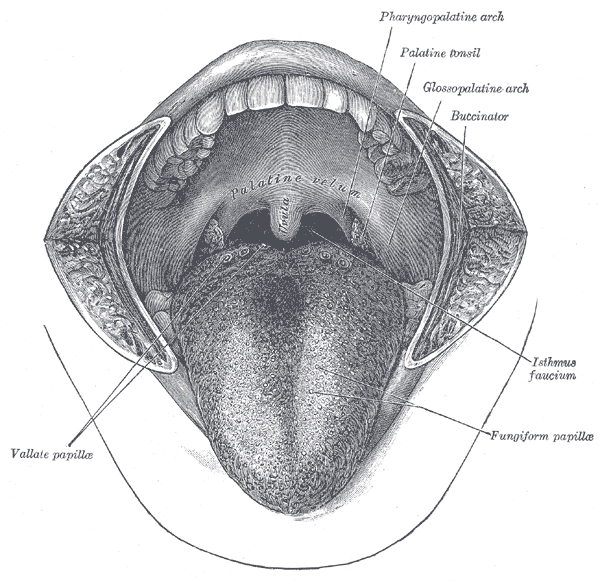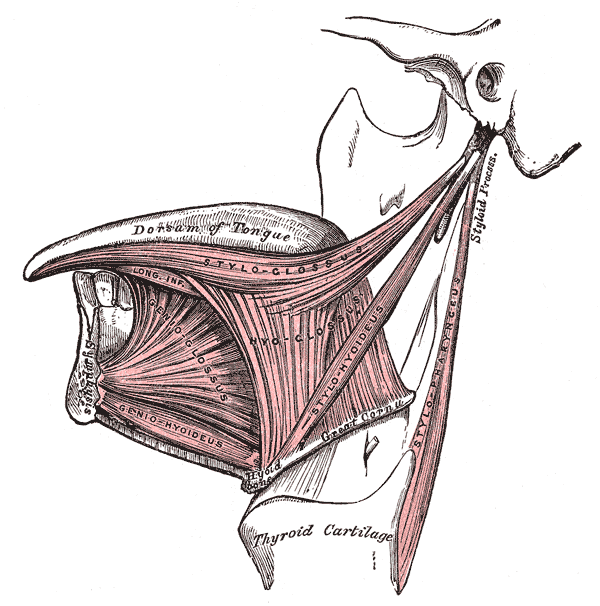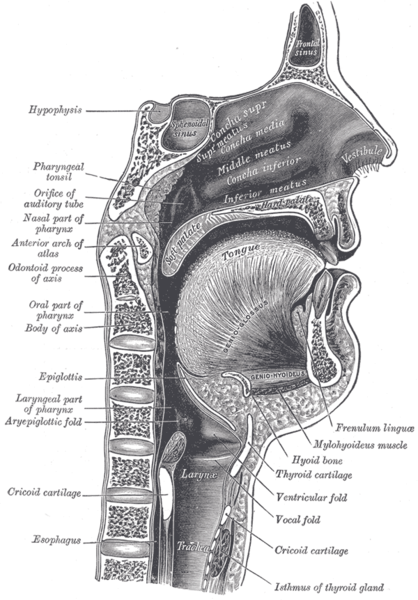Tongue
 From Wikidoc - Reading time: 11 min
From Wikidoc - Reading time: 11 min
Editor-In-Chief: C. Michael Gibson, M.S., M.D. [1]
Overview[edit | edit source]
|
WikiDoc Resources for Tongue |
|
Articles |
|---|
|
Media |
|
Evidence Based Medicine |
|
Clinical Trials |
|
Ongoing Trials on Tongue at Clinical Trials.gov Clinical Trials on Tongue at Google
|
|
Guidelines / Policies / Govt |
|
US National Guidelines Clearinghouse on Tongue
|
|
Books |
|
News |
|
Commentary |
|
Definitions |
|
Patient Resources / Community |
|
Directions to Hospitals Treating Tongue Risk calculators and risk factors for Tongue
|
|
Healthcare Provider Resources |
|
Continuing Medical Education (CME) |
|
International |
|
|
|
Business |
|
Experimental / Informatics |
The tongue is the large bundle of skeletal muscles on the floor of the mouth that manipulates food for chewing and swallowing (deglutition). It is the primary organ of taste. Much of the surface of the tongue is covered in taste buds. The tongue, with its wide variety of possible movements, assists in forming the sounds of speech. It is sensitive and kept moist by saliva, and is richly supplied with nerves and blood vessels to help it move.
The tongue is often cited as the "strongest muscle in the body," a claim that does not correspond to any conventional definition of strength. For more on this subject, see Muscle: The strongest human muscle.
"Tongue" as a word[edit | edit source]
The word tongue can be used as a metonym for language, as in the phrase mother tongue. In fact, Albanian (gjuha), Catalan (llengua), Portuguese (língua), French (langue), Maltese, (ilsien), Arabic (لسان lisān), Romanian (limba), Russian (язык yazyk), Bulgarian (ezik), Persian (zabaan), Greek (γλώσσα), Spanish (lengua), Polish, Slovak, Czech, Slovene, Bosnian, Serbian, Croatian ( jezik), Armenian (լեզու), Finnish (kieli), Estonian (keel), Irish, Icelandic (tunga), Italian (lingua), Latin (lingua), Urdu (za'baan), Aramaic (ܠܫܢܐ/לשנא lišānā), Hungarian (nyelv), Hebrew (לָשׁוֹן lashon), and Turkish (dil), have the same word for "tongue" and "language". A common temporary failure in word retrieval from memory is referred to as the tip-of-the-tongue phenomenon. The term "tongue in cheek" also exists. "Tongue twisted" is a term used to described being unable to pronounce a word or phrase correctly. A "tongue twister" is a phrase made specifically to be very difficult to pronounce. An example of a tongue twister is: She sells seashells by the seashore. Another example is: Peter Piter picked a peck of pickled peppers. If Peter Piter picked a peck of pickled peppers, how many pickled peppers did Peter Piter pick? Tongue Twisters are meant to trick your tongue.
Anatomy[edit | edit source]
Structure[edit | edit source]


The tongue is made mainly of skeletal muscle. The tongue extends much further than is commonly perceived, past the posterior border of the mouth and into the oropharynx.
The dorsum (upper surface) of the tongue can be divided into two parts:
- an oral part (anterior two-thirds of the tongue) that lies mostly in the mouth
- a pharyngeal part (posterior third of the tongue), which faces backward to the oropharynx
The two parts are separated by a V-shaped groove, which marks the sulcus terminalis (or terminal sulcus).
Since the tongue contains no bony supports for the muscles, the tongue is an example of a muscular hydrostat, similar in concept to an octopus arm. Instead of bony attachments, the extrinsic muscles of the tongue anchor the tongue firmly to surrounding bones and prevent the mythical possibility of 'swallowing' the tongue.
Other divisions of the tongue, are based on the area of the tongue:
| normal name | anatomical name | adjective |
|---|---|---|
| tongue tip | apex | apical |
| tongue blade | lamina | laminal |
| tongue dorsum | dorsum (back) | dorsal |
| tongue root | radix | radical |
| tongue body | corpus | corporeal |
Muscles of the tongue[edit | edit source]
The intrinsic muscles lie entirely within the tongue, while the extrinsic muscles attach the tongue to other structures.

The extrinsic muscles reposition the tongue, while the intrinsic muscles alter the shape of the tongue for talking and swallowing.
Extrinsic muscles[edit | edit source]
Extrinsic muscles of the tongue by definition originate from structures outside the tongue and insert into the tongue. The four paired extrinsic muscles protrude, retract, depress, and elevate the tongue:
| Muscle | From | Nerve | Function |
| Genioglossus muscle | mandible | hypoglossal nerve | protrudes the tongue as well as depressing its center. |
| Hyoglossus muscle | hyoid bone | hypoglossal nerve | depresses the tongue. |
| Styloglossus muscle | styloid process | hypoglossal nerve | elevates and retracts the tongue. |
| Palatoglossus muscle | palatine aponeurosis | pharyngeal branch of vagus nerve | depresses the soft palate, moves the palatoglossal fold towards the midline, and elevates the back of the tongue. |
Intrinsic muscles[edit | edit source]

Four paired intrinsic muscles of the tongue originate and insert within the tongue, running along its length. These muscles alter the shape of the tongue by: lengthening and shortening it, curling and uncurling its apex and edges, and flattening and rounding its surface.[1]
- The superior longitudinal muscle runs along the superior surface of the tongue under the mucous membrane, and elevates, assists in retraction of, or deviates the tip of the tongue. It originates near the epiglottis, the hyoid bone, from the median fibrous septum.
- The inferior longitudinal muscle lines the sides of the tongue, and is joined to the styloglossus muscle.
- The verticalis muscle is located in the middle of the tongue, and joins the superior and inferior longitudinal muscles.
- The transversus muscle divides the tongue at the middle, and is attached to the mucous membranes that run along the sides.
Papillae and taste buds[edit | edit source]
The oral part of the tongue is covered with small bumpy projections called papillae. There are four types of papillae:
- filiform (thread-shape)
- fungiform (mushroom-shape)
- circumvallate (ringed-circle)
- foliate
All papillae except the filiform have taste buds on their surface.

The circumvallate are the largest of the papillae. There are 8 to 14 circumvallate papillae arranged in a V-shape in front of the sulcus terminalis, creating a border between the oral and pharyngeal parts of the tongue.
There are no lingual papillae on the underside of the tongue. It is covered with a smooth mucous membrane, with a fold (the lingual frenulum) in the center. If the lingual frenulum is too taut or too far forward, it can impede motion of the tongue, a condition called Tongue-tie (Ankyloglossia).
The upper side of the posterior tongue (pharyngeal part) has no visible taste buds, but it is bumpy because of the lymphatic nodules lying underneath. These follicles are known as the lingual tonsil.
The human tongue can detect five basic taste components: sweet, sour, salty, bitter and umami. The sense of taste is referred to as a gustatory sense. Contrary to the popular myth and generations of schoolbooks, there are no distinct regions for tasting different tastes. This myth arose because Edwin_G._Boring replotted data from one of Wundt's students (Hanig) without labeling the axes, leading some to misinterpret the graph as all or nothing response. [2] The common conception of taste has a significant contribution from olfaction.
Innervation of the tongue[edit | edit source]
Motor innervation of the tongue is complex and involves several cranial nerves. All the muscles of the tongue are innervated by the hypoglossal nerve (cranial nerve XII) with one exception: the palatoglossal muscle is innervated by the pharyngeal branch of vagus nerve (cranial nerve X).
Sensory innervation of the tongue is different for taste sensation and general sensation.
- In the pharyngeal part of the tongue (posterior third), taste and general sensations are carried by the glossopharyngeal nerve (cranial nerve IX).
- Somatic sensations from the oral part of the tongue (anterior two-thirds) (as well as areas of the oral mucosa and gingiva of the lower teeth) travel from the tongue via the lingual nerve, a major branch of the mandibular nerve (itself a branch of the trigeminal nerve, cranial nerve V). Taste sensation of the anterior two-thirds of the tongue is carried to the facial nerve via the chorda tympani. The chorda tympani also carries parasmpathetic fibers from the facial nerve to the submandibular ganglion.
Vasculature of the tongue[edit | edit source]

The tongue receives its blood supply primarily from the lingual artery, a branch of the external carotid artery. The floor of the mouth also receives its blood supply from the lingual artery.
There is also secondary blood supply to the tongue from the tonsillar branch of the facial artery and the ascending pharyngeal artery.
Use of tongue in pharmacy[edit | edit source]
The sublingual region underneath the front of the tongue is a location where the oral mucosa is very thin, and underlied by a plexus of veins. This is an ideal location for introducing certain medications to the body. The sublingual route takes advantage of the highly vascular quality of the oral cavity, and allows for the speedy application of medication into the cardiovascular system, bypassing the gastrointestinal tract. This is the only convenient and efficacious route of administration of nitroglycerin to a patient suffering angina pectoris, chest pain. If the tablet is swallowed, the medication is completely neutralized by the detoxification process of the liver.
Clinical significance[edit | edit source]
White tongue: White spots and patches or coating of the tongue are a symptom of several medical conditions:
- Antibiotics side effect
- Oral candidiasis
- Dehydration
- Leukoplakia
- Keratosis pharyngis
- Jaundice - causes a yellow tongue
- "Lie Bumps" - small dots usually on tip of tongue
The tongue is also examined and observed diagnostically in traditional Chinese medicine. A painful tongue may be an indication of several underlying serious medical conditions [3]
Secondary uses[edit | edit source]
In addition to eating and human vocalization, the human tongue has many secondary uses. These include certain forms of kissing known as "tongue kissing" or sometimes "french kissing" in which the tongue plays a primary role. Generally, use of the tongue (such as licking), or interaction between tongues, appears to be a common gesture of affection, not just in humans but throughout the animal kingdom, and particularly in mammals.
The tongue also has a distinct use in both male and female forms of oral sex, and is typically used to a great extent in foreplay and traditional sexual intercourse as well. Because of its use in both the phenomenon of human sexual interactions, the tongue sometimes is associated with a sensual or erotic connotation. In art the human tongue is often depicted as a seductive instrument, similar to the status of the lips.

The tongue is also one of the more common parts of the human anatomy to be subject to piercing and body modification, a phenomenon that is sometimes associated with certain subcultures or demographics. Tongue piercing has appeared historically in many ancient cultures, and is an increasingly popular trend in the West today, particularly in youth culture. Pop culture references to tongue piercings are common as well.
Showing tongue (tongue out) is an international emotional gesture used primarily by children, or by adults behaving (deliberately or not) in a childish manner.
The human tongue also plays a valuable role in other acts, such as for blowing bubbles with bubble gum and whistling.
Injury to the tongue is often very painful. The muscle is vulnerable to various cancers.
Non-human tongues[edit | edit source]

Most multi-cellular animals, that is, members of the subkingdom Metazoa, have tongues or similar organs.
In animals, such as dogs and cats, the tongue is often used to clean the fur and body. Rough textures of the tongues of these species helps them to use their tongues to remove oils and parasites by licking themselves and each other. Aside from daily uses for eating and drinking, a dog's tongue acts as a heat regulator. As a dog increases its exercise the tongue will increase in size due to greater blood flow. The tongue hangs out of the dog's mouth and the moisture on the tongue will cool down further cooling down the bloodflow.[2][3]
Some animals have prehensile tongues. For example, chameleons, frogs, salamanders and some species of fish use their tongues to catch prey. Many insects have a type of tongue called a proboscis that is used for the same purpose or, in the case of butterflies, to drink nectar [4]. The corresponding organ in ants is called the hypopharynx [5]. Molluscs have a rough tongue called a radula [6], which they use to grind food.
Tongue rolling[edit | edit source]

Tongue rolling is the act of rolling the tongue axially into a tube shape. The ability to roll the tongue has been generally believed to depend on genetic inheritance. Tongue rolling was believed to be a dominant trait with simple Mendelian inheritance, and is still commonly used as an example in high school and introductory biology courses. It provided a simple experiment to demonstrate inheritance.
There is little laboratory evidence, though, for the common belief that tongue rolling is inheritable and dominant. A 1975 twin study found that identical twins (who share all of their genes) were no more likely than fraternal twins (who share an average of half) to both have the same phenotype for tongue rolling.[4][5]
Tongue as a food[edit | edit source]
The tongues of some animals are consumed and sometimes considered delicacies. In America and the United Kingdom, cow tongues are among the more common. Hot tongue sandwiches are frequently found on menus in Kosher delicatessens and in America. In the United Kingdom tongue can often be found at the local grocer, where it is often sold in reformed slices of meat after being ground up and set in gelatine. Taco de lengua (lengua being Spanish for tongue) is a taco filled with beef tongue, and is especially popular in Mexican cuisine. Tongue can also be prepared as birria. Duck tongues are sometimes employed in Szechuan dishes, while lamb's tongue is occasionally employed in Continental and contemporary American cooking. Fried cod tongue is a relatively common part of fish meals in Norway and Newfoundland.
Tongues are also used in sausage making. Historically, buffalo tongue was once considered an especially exquisite dish, and is one of the reasons for the American Bison being hunted by humans to the point of near extinction.
Miscellaneous facts[edit | edit source]
- Tung was the original Webster spelling of tongue
- Stephen Taylor holds the world record for the world's longest tongue. It measures 9.5 centimeters from the tip to the center of his closed top lip. Annika Irmler holds the record for longest female tongue, at 7 centimeters.[6]
Additional images[edit | edit source]
-
The entrance to the larynx, viewed from behind.
-
Sagittal section of nose mouth, pharynx, and larynx.
See also[edit | edit source]
- Electronic tongue
- Glossitis (tongue inflammation)
- Human anatomy
- Language
- List of Mendelian traits in humans
- Saliva
- Taste buds on the tongue
- Tip-of-the-tongue phenomenon
- Tongue bifurcation
- Tongue piercing
- Tongue-twister
- Vocal tract
External links[edit | edit source]
- Template:Stedman's
- Anatomy of the vocal tract at umanitoba.ca
- University of Manitoba, Anatomy of the Vocal Tract
Template:Oral pathology
Template:Gustatory system
Template:Human anatomical features
Template:Head and neck general
References[edit | edit source]
- ↑ Drake, R. et al. Gray's Anatomy for Students, Elsevier, 2005. ISBN 0-443-06612-4
- ↑ Bartoshuk, L.M. (1989). Taste: Robust across the Age Span? Annals of the New York Academy of Sciences 561, pp. 65-75.
- ↑ "Painful tongue".
- ↑ http://www.discovery.com/area/skinnyon/skinnyon970226/skinny1.html
- ↑ http://www.ncbi.nlm.nih.gov/entrez/dispomim.cgi?id=189300
- ↑ 'I've got the world's longest tongue' Retrieved 24 April 2007.
ar:لسان
bg:Език (биология)
ca:Llengua (múscul)
cs:Jazyk (orgán)
cy:Tafod
da:Tunge
de:Zunge
el:Γλώσσα (ανατομία)
eo:Lango (anatomio)
gd:Teanga
ko:혀
hr:Jezik (anatomija)
id:Lidah
ia:Lingua (anatomia)
it:Lingua (anatomia)
he:לשון (איבר)
ka:ენა (ორგანო)
la:Lingua (membrum)
lt:Liežuvis
ln:Lolému
hu:Nyelv (testrész)
mk:Јазик (анатомски орган)
ml:നാവ്
nl:Tong (anatomie)
no:Tunge
nn:Tunge
rmy:Chhib (korposki)
qu:Qallu
simple:Tongue
sk:Jazyk (orgán)
fi:Kieli (anatomia)
sv:Tunga
ta:நாக்கு
te:నాలుక
th:ลิ้น
tg:Забон (андом)
uk:Язик
fiu-vro:Kiil (anatoomia)
yi:צונג
zh-yue:脷
diq:Zıwan (organ)
 KSF
KSF
